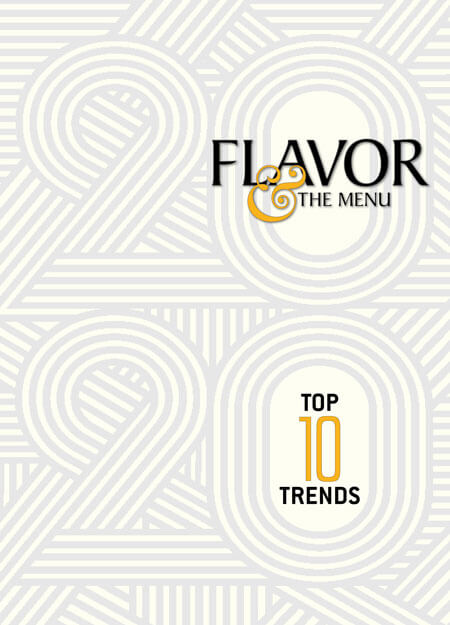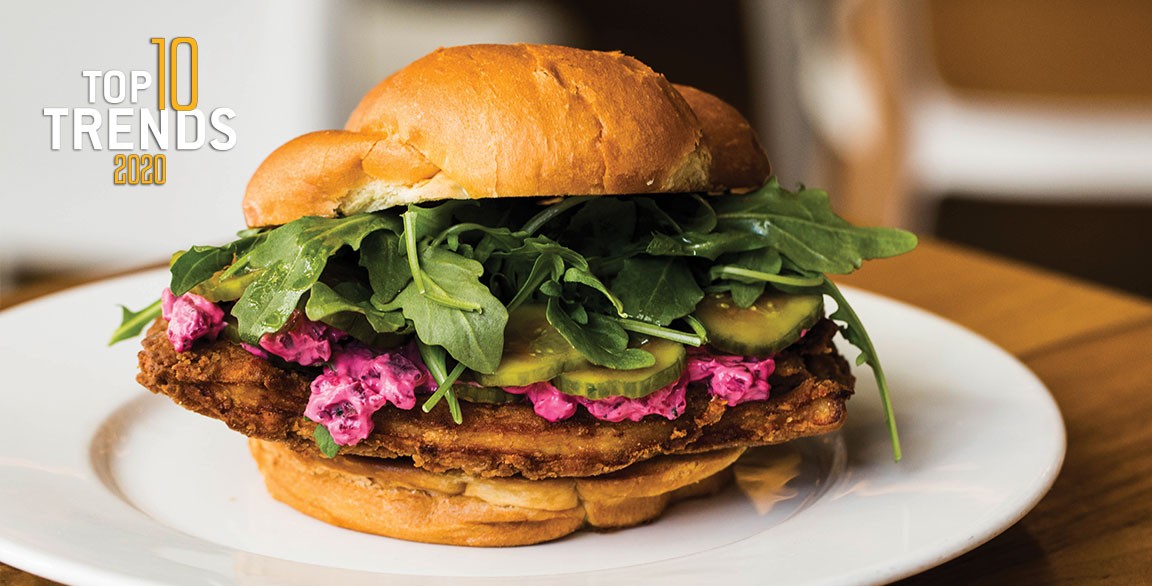

The Israeli Hot Chicken at Yafo Kitchen, a Mediterranean street food fast casual in Charlotte, N.C., mashes American Southern with Eastern Mediterranean, relying on red s’chug for the signature high heat in its fried chicken.
Chicago’s Beatnik, a New American restaurant, combines Japanese with Eastern Med through its flavor-rich miso and date glaze on Heirloom Carrots, served with a roasted beet tahini, bottarga and dill. These types of mash-ups are surprising, yet not polarizing, thanks to the growing familiarity of Eastern Mediterranean flavors. The intrigue factor in dishes like these, wrapped in a newfound comfort level from dining consumers, makes Eastern Med mash-ups a treasure trove of opportunity for menu developers.
The flavors and formats of countries such as Turkey, Syria, Israel and Lebanon exploded onto the culinary scene a few years back, due to a winning trifecta of shareability, craveability and an overarching drive by diners to explore new flavor frontiers. Many of those once-niche items, including harissa, falafel and shawarma, have now become familiar.
“Italian, Mexican and Chinese have long been the world cuisines that American diners are completely comfortable with,” says Maeve Webster, president of Menu Matters. “Eastern Mediterranean is gliding into that realm. Even if consumers don’t understand it as a cuisine, elements of it have moved into the mainstream—think about hummus, Greek yogurt and tzatziki, for example—making them very comfortable with seeing those ingredients, flavors and formats presented in creative ways. As a result, American chefs are ready to borrow from that region and fuse it with other global cuisines to make things exciting for their guests.”
Forward-thinking concepts are melding Eastern Med with cuisines like Mexican, Japanese, Californian and Southern, creating flavor adventures in surprising mash-ups that carry forth a recognizable foundation. “At its core, this trend is still about replicating familiar flavors with the help of a modern twist,” says Rob Corliss, chef/founder of All Things Epicurean (ATE). “Mash-ups don’t need to be complicated.”
The Syrian Caesar Salad at Nur, a modern Middle Eastern restaurant in New York, showcases that strategy, punctuating an American menu staple with ingredients from the Eastern Med, combining romaine, kale, Brussels sprouts and charred cabbage with Parmigiano, puffed bulgur, toasted challah croutons and an anchovy-za’atar vinaigrette.
“Eastern Med ingredients and flavors are a natural fit for crafting craveable, new menu experiences,” says Corliss. He points to San Francisco’s Noosh, a restaurant that couples Eastern Med with a California vibe. Its Greek Po’Boy sandwich layers fried calamari and smoked tzatziki into a “chubby” pita. “This natural fit marries Americans’ love of sandwiches, Eastern Med flavors and the value of premium ingredients into a deliciously memorable build,” he says.
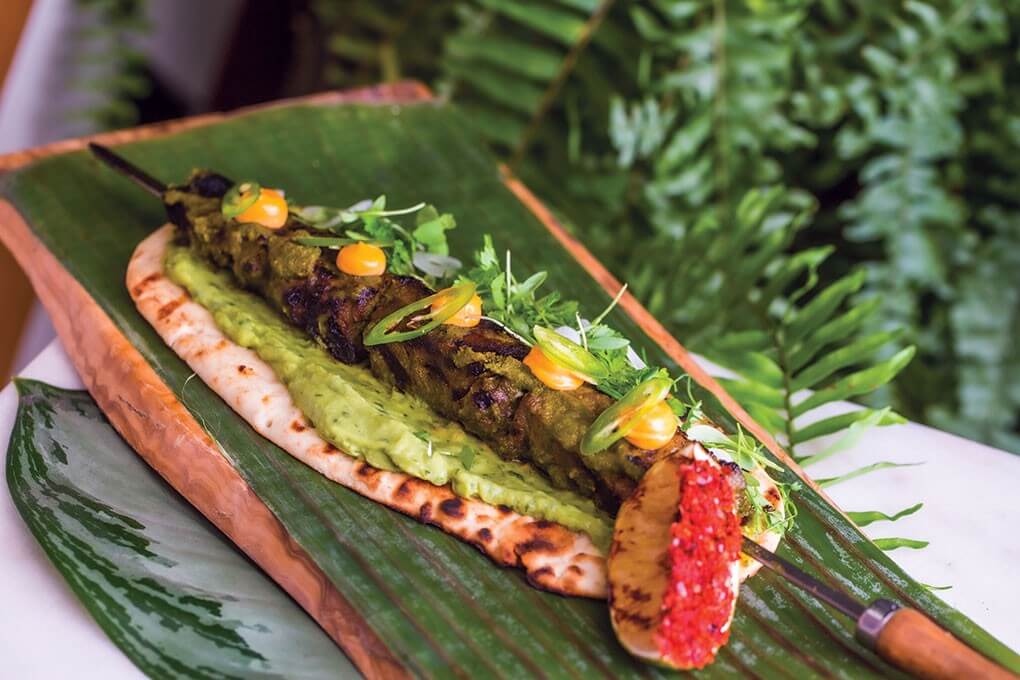 Beatnik
Beatnik The Taco Arabe at Chicago’s Beatnik is a clever combo of Mexican and Eastern Med, with grilled pork shoulder, manteca-guajillo aïoli, avocado salsa verde and pickled pearl onion on naan.
FLAVOR-RICH OPPORTUNITY
When taking a top-line inventory of the Eastern Med flavors and formats that have made big moves on menus here—hummus, falafel, s’chug, kebabs, dukkah, za’atar, tahini, feta, halloumi and flatbreads—a common bond forges their collective pathway to victory. They often carry a dual message of freshness and indulgence. With that winning combination, it makes sense that chefs are using Eastern Med to springboard into creative menu development themed around the mash-up.
“There’s big opportunity in playing with Eastern Med formats and applying spice blends from Japan, Mexico or Vietnam, for example,” says Webster. “A number of the Eastern Mediterranean’s most familiar formats are recognizable throughout the world—flatbreads are in every culture, many cuisines boast some kind of kebab, and many have bean or vegetable dips.” That makes them incredibly adaptable, bending easily into a mash-up that is altogether new, but astonishingly familiar.
“Cooking on skewers over charcoal fire is a common technique in the Eastern Mediterranean,” says Chris Koetke, chef/founder of Complete Culinary consultancy, pointing to the broad opportunities. “Imagine the possibilities as this technique is combined with Mexican or Asian flavor profiles. Or in reverse: the possibilities for introducing sumac, Turkish spice blends or Turkish chiles into yakitori or taco combinations.”
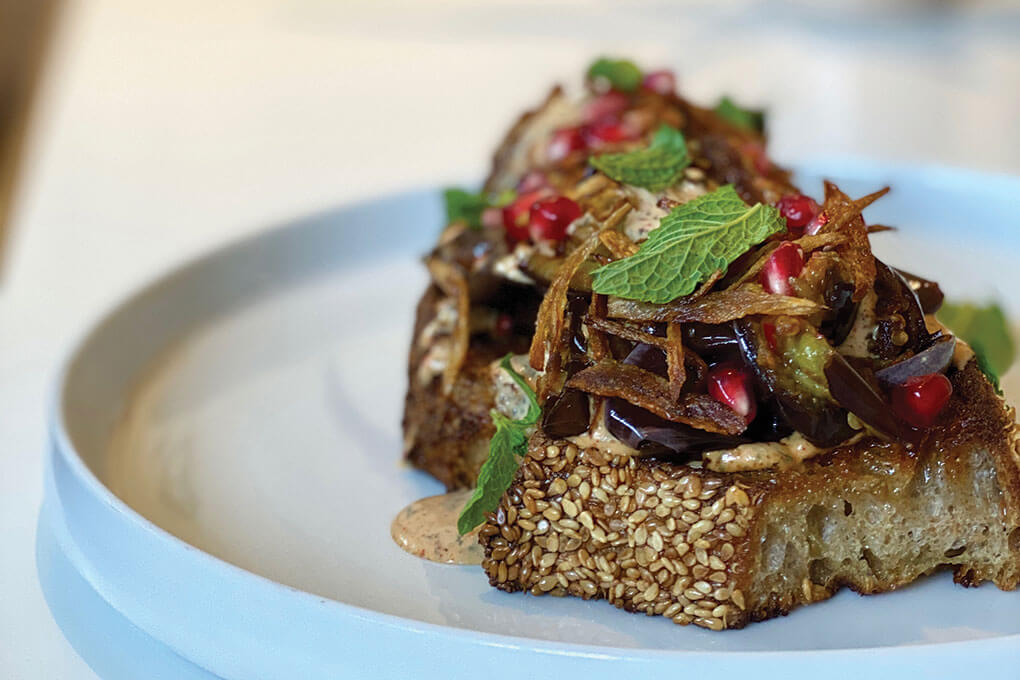 Kismet
Kismet Kismet in Los Angeles finds harmony between Eastern Med and California cuisines in its Eggplant Toast with tahini, pomegranate, fried shallots and mint.
Miss Ada, a modern Mediterranean spot in Brooklyn, N.Y., runs with the Mexican-Eastern Med mash-up for its Short Rib Skewer, served with an Israeli mole and puffy pita. The mole sees a combination of baharat, harissa and chocolate.
“The chocolate works really well with the spice blend, which has cinnamon, cardamom, clove, black pepper and a hot spice that brings depth. Harissa gives it a kick,” says Tomer Blechman, chef/owner. “I believe that Miss Ada doesn’t need to just have Mediterranean flavors. If we make something and it works well, it will be on the menu.”
The restaurant’s cocktail menu reflects a similar sensibility, building drinks that reach into global pantries, introducing guests to spirits like arak, an anise-flavored aperitif, in cocktails like the Thyme After Time, along with gin, chickpea aquafaba and thyme. The Dead Sea, touted by some as an “Israeli margarita,” sees guava, mezcal, mint, lime and sea salt.
Back at Beatnik in Chicago, the Eastern Med meets Mexico in its Taco Arabe with grilled marinated pork shoulder, manteca and guajillo pepper aïoli, avocado salsa verde, pickled pearl onion and grilled naan.
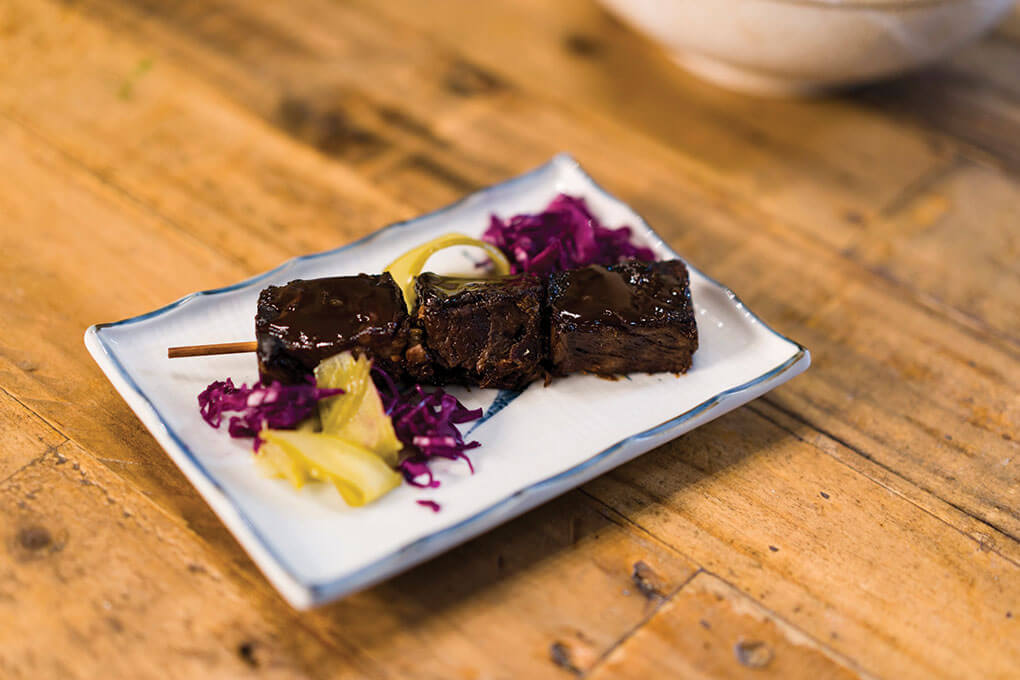 Miss Ada
Miss Ada The Short Rib Skewer at Miss Ada in Brooklyn, N.Y., melds Mexican flavors with Eastern Med through its Israeli mole, made with baharat, harissa and chocolate.
When looking east toward Japan for mash-up inspiration, the term “meppon” seems to have taken hold in England, calling out Japanese techniques applied to Mediterranean ingredients. Sweet miso marinated eggplant at London’s Zela is a good example.
In the United States, the term “MediterrAsia” has been adopted, at least by Mila, a concept opening soon in Miami, drawing inspiration from Japan and the Mediterranean regions. Menu items like lamb chops with shiso-cilantro pesto promise an intriguing flavor complexity, leaning on Mediterranean ingredients to cushion the dish in familiarity.
New American and Eastern Med are natural partners, offering the broadest opportunity for menu adaptation. “They share themes of fresh ingredients, seasonality, smaller portions and lighter fare,” says Webster.
Kismet in Los Angeles combines Mediterranean ingredients with California cuisine, leading with bright, fresh flavors, as seen in its Eggplant Toast with tahini, mint, pomegranate and fried shallots.
Also in Los Angeles, The Exchange restaurant touts a mash-up of Californian and Israeli cuisine. Here, sweet potatoes are served with almond purée and chile morita, and fries are paired with an amba mayo dipping sauce, elevating the familiar experience with a tangy mango flavor.
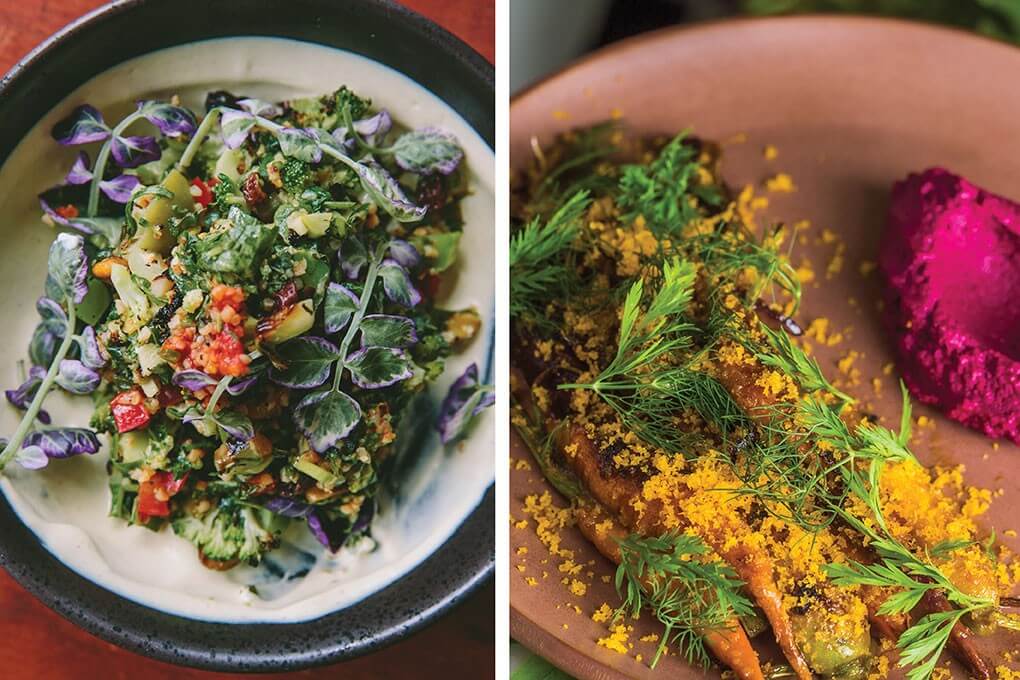 Left: Brian Samuels; right: Beatnik
Left: Brian Samuels; right: Beatnik New American veg-centric dishes play well with Eastern Med flavors. At Sarma in Somerville, Mass., Broccoli Tabbouleh is layered atop pistachio labneh, while miso-date glazed carrots are paired with roasted-beet tahini at Beatnik in Chicago.
Bryan Weaver, executive chef of Butcher & Bee, an eclectic American restaurant with locations in Nashville, Tenn., and Charleston, S.C., celebrates the lighter side of modern American mash-ups with dishes like his Dukkah Pole Beans, with almond, lemon and garlic confit, and his Basic Bee Salad, dressed with a tahini green goddess dressing. He also ably moves Eastern Med into the comfort side of Southern cooking with his Israeli Fried Chicken, flavored with sumac, Persian lime, tulsi basil and local honey.
“We’re in the South, but one of the partners is from Israel and wanted a connection to that cuisine, so I started reading about it and exploring the possibilities,” he says. “The flavors of the South and the flavors of Israel create a mash-up that seems natural, not forced. They work really well together.” He seasons the fried chicken heavily with sumac and finishes it with a garnish of the Persian black lime. “The sumac gives it a cool color and a hint of acid,” says Weaver.
Sarma, a modern Mediterranean restaurant in Somerville, Mass., was one of the pioneers in the mash-up, expressing a gleeful abandon of boundaries, expertly lifting the flavor experience by adding ingredients from powerhouse cuisines like Mexican, Southern, Southeast Asian and Japanese. Its Pork Belly Biscuits with jalapeño-whipped feta and cider are another demonstration of the easy friendship between Eastern Med and Southern cuisines.
On the dessert menu at Sarma, the Dukkah Crackerjacks serve as a reminder that fun never goes out of successful menu development. “All of these iterations are great for the industry because they raise the level of innovation and keep things vibrant,” says Webster. “The Eastern Med mash-up will continue to evolve as we dig further into that region, while also blending it with other world cuisines.”
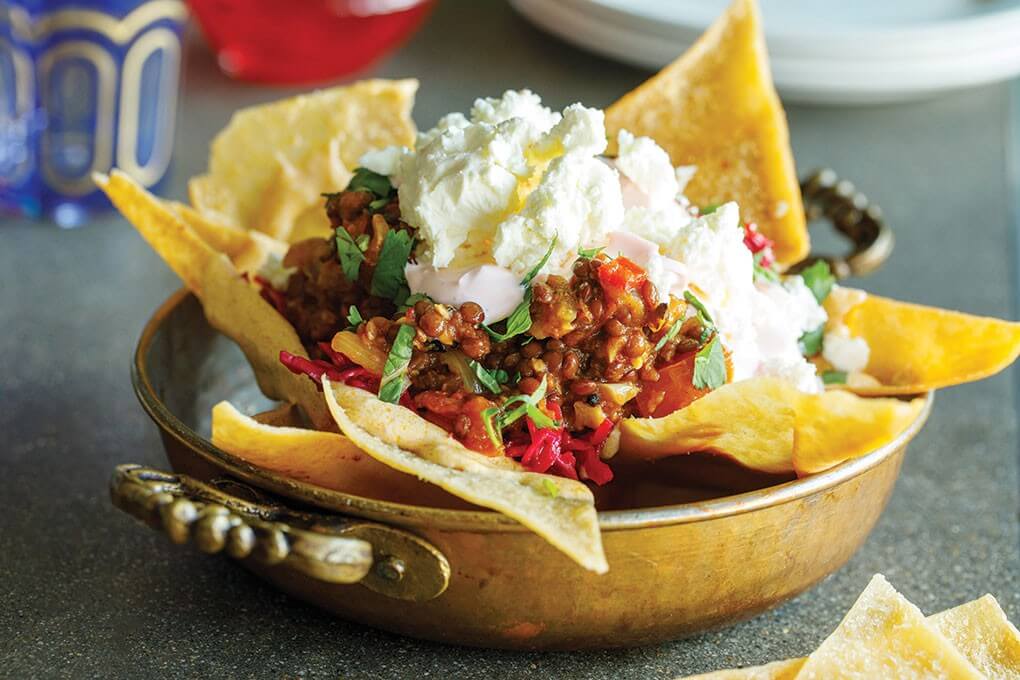
Sarma in Somerville, Mass., serves a fun mash-up of Lentil Nachos topped with radish tzatziki, feta cheese and cilantro.







